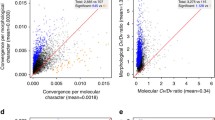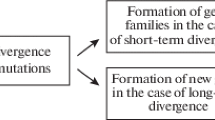Abstract
Essential differences between genetic and morphofunctional characteristics as sources of information about evolutionary development are discussed using examples of mammal taxa. The approaches to combined analysis of data characterizing different levels of biological organization in phylogenetic reconstructions are considered using examples of certain mammalian taxa.
Similar content being viewed by others
References
A. K. Agadjanian, “Small Mammals from the Pliocene-Pleistocene of the Russian Plain,” Doctoral Dissertation in Biology (Paleontol. Inst. Akad. Nauk SSSR, Moscow, 1992).
A. K. Agadjanian, “Questions of Early Adaptive Radiation of Mammals,” Paleontol. Zh., No. 1, 78–91 (2003a) [Paleontol. J. 37 (1), 76–88 (2003a)].
A. K. Agadjanian, “Adaptive Radiation of Mammals: Major Stages,” Paleontol. Zh., No. 2, 73–81 (2003b) [Paleontol. J. 37 (2), 179–186 (2003b)].
V. Barriel, E. Thuet, and P. Tassy, “Molecular Phylogeny of Elephantidae: Extreme Divergence of the Extant Forest African Elephant,” CR Acad. Sci. Paris 322, 447–454 (1999).
F. C. Chen and W. H. Li, “Genomic Divergences between Humans and Other Hominoids and the Effective Population Size of the Common Ancestor of Humans and Chimpanzees,” Am. J. Hum. Genet. 68, 444–456 (2001).
S. S. Chetverikov, “On Certain Points of the Evolutionary Process from the Point of View of Modern Genetics,” Zh. Eksperimental. Biol., Ser. A, No. 2, 3–54 (1926).
S. S. Chetverikov, Problems of General Biology and Genetics (Reminiscences, Research Works, and Lectures) (Nauka, Novosibirsk, 1983) [in Russian].
A. W. Crompton, “On the Lower Jaw of Diarthrognathus and the Origin of the Mammalian Lower Jaw,” Proc. Zool. Soc. London 140, 441–452 (1963).
R. Debruyne, “Molecular Phylogeny of Living Elephants and Discussion on Infraspecific Systematics of Loxodonta africana and Elephas maximus,” in The World of Elephants: International Congress (Rome, 2001), pp. 628–629.
R. Debruyne, V. Barriel, and P. Tassy, “Mitochondrial Cytochrome b of the Lyakhov Mammoth (Proboscidea, Mammalia): New Data and Phylogenetic Analyses of Elephantidae,” Mol. Phylogenet. Evol. 26, 421–434 (2003).
M. Derenko, B. Malyarchuk, and G. F. Shields, “Mitochondrial Cytochrome b Sequence from a 33000 Year-Old Woolly Mammoth (Mammuthus primigenius),” Anc. Biomol. 1, 149–153 (1997).
I. A. Dubrovo, “Fossil Proboscideans,” Geol. Zb. Velenje Yugosl. 12 (Pliocenski in pleistocenski vretencarji saleske Kotline in Primerjava s sirsim prostorom), 159–197 (1997).
I. A. Dubrovo and G. S. Rautian, “Comparative Analysis of Genetic Diversity in Mammoth,” in 2nd International Mammoth Conference, Amsterdam, May 17–21 (Amsterdam, 1999), pp. 15–17.
J. Felsenstein, “Confidence-limits on Phylogenies with a Molecular Clock,” Syst. Zool. 34, 152–161 (1985).
S. M. Gershenzon, “Mobilization Reserve of Intraspecific Variation,” Zh. Obshch. Biol. 2(1), 85–107 (1941).
A. Gopalakrishna and G. C. Chari, “A Review of the Taxonomic Position of Miniopterus Based on Embryological Characters,” Curr. Sci. 52, 1176–1180 (1983).
A. Gopalakrishna and K. B. Karim, “Female Genital Anatomy and the Morphogenesis of Foetal Membranes of Chiroptera and Their Bearing on the Phylogenetic Relationships of the Group,” Nat. Acad. Sci., India Golden Jubilee Commemoration Volume, 380–428 (1980).
E. Hagelberg, M. G. Thomas, Ch. E. Cook, et al., “DNA from Ancient Mammoth Bones,” Nature 370, 333–334 (1994).
J. Hauf, A. Bauer, N. Chalwatzis, et al., “Selective Amplification of a Mammoth Mitochondrial Cytochrome b Fragment Using an Elephant-specific Primer,” Curr. Genet. 27, 486–487 (1995).
J. Hauf, U. Joger, F. K. Zimmermann, et al., “Protein and Nucleic Acid Sequences of Woolly Mammoth Cytochrome b and the Phylogenetic Position of Mammuthus within the Elephantidae,” Deinsea Rotterdam 6 (Suppl.: Mammoths and the Mammoths Fauna: Proceedings of the First International Mammoth Conference, St. Petersburg, Russia, Ed. by G. Haynes, J. Klimowicz, and W. Reumer), pp. 211–217 (1999).
J. Hauf, N. Chalwatzis, U. Joger, and F. K. Zimmermann, “The Complete Mitochondrial Genome Sequence of the African Elephant (Loxodonta africana) and Its Implication for the Assessment of the Systematic Position of the Proboscidea,” Zoology 102, 184–195 (2000).
I. Horacek, “Kerivoula (Mammalia, Chiroptera), a Fossil in Europe?,” Acta Univ. Carolinae, Geol. Spin., No. 2, 213–222 (1986).
M. Höss, M. Pääbo, and N. K. Vereshchagin, “Mammoth DNA Sequences,” Nature 370, 333 (1994).
U. Joger, G. Garrido, J. Hauf, et al., “Genetic Investigations on Mammoth (Mammuthus primigenius),” Deinsea 9, 205–220 (2003).
M. Kimura, The Neutral Theory of Molecular Evolution (Cambridge Univ. Press, Cambridge, 1983).
M.-C King and A. C. Wilson, “Evolution at Two Levels: Molecular Similarities and Biological Differences between Humans and Chimpanzees,” Science 188, 107–116 (1975).
V. A. Krassilov, “Origin and Early Evolution of Flowering Plants” (Nauka, Moscow, 1989) [in Russian].
J. Krause, P. H. Dear, J. L. Pollack, et al., “Multiplex Amplification of the Mammoth Mitochondrial Genome and the Evolution of Elephantidae,” Nature Publishing Group (2005) (doi:10.1038/nature04432)
J. B. Kruskal, “Nonmetric Multidimensional Scaling: A Numerical Method,” Psychometrika 29(2), 115–129 (1964).
A. V. Lopatin, “Early Paleogene Insectivores and Modern Taxonomic System of Lipotyphla,” in Modern Paleontology: Classical and New Methods (Paleontol. Inst. Ross. Akad. Nauk, Moscow, 2005), pp. 133–154 [in Russian].
J. M. Lowenstein, “Radioimmune Assay of Mammoth Tissue,” Acta Zool. Fen. 170, 233–235 (1985).
O. Madsen, M. Scally, C. J. Douady, et al., “Parallel Adaptive Radiations in Two Major Clades of Placental Mammals,” Nature 409, 610–614 (2001).
V. J. Maglio, “Origin and Evolution of the Elephantidae,” Trans. Am. Phil. Soc., New Ser. 63(3), 1–149 (1973).
L. H. Matthews, “Notes on the Genitalia and Reproduction of Some African Bats,” Proc. Zool. Soc. London, Ser. B 111, 289–346 (1942) (after Hoofer and Bussche, 2003).
P. Mein and Y. Tupinier, “Formule dentaire et position systematique du Minioptere (Mammalia, Chiroptera),” Mammalia 41, 207–211 (1977).
S. V. Meyen, Fundamentals of Paleobotany (Nedra, Moscow, 1987) [in Russian].
G. S. Miller, Jr., and G. M. Allen, “The American Bats of the Genera Myotis and Pizonyx,” Smithson. Inst. US Nat. Mus. 144, 1–218 (1928).
G. S. Miller, Jr., “The Families and Genera of Bats,” Bull. US Nat. Mus. 57, 1–282 (1907).
H. J. Muller, “Our Load of Mutations,” Am. J. Hum. Genet. 2, 111–176 (1950).
W. J. Murphy, E. Eizirik, W. E. Johnson, et al., “Molecular Phylogenetics and the Origins of Placental Mammals,” Nature 409, 614–618 (2001a).
W. J. Murphy, E. Eizirik, S. J. O’Brien, et al., “Resolution of the Early Placental Mammal Radiation Using Bayesian Phylogenetics,” Science 294, 2348–2351 (2001b).
M. Noro, R. Masuda, I. A. Dubrovo, et al., “Molecular Phylogenetic Inference of the Woolly Mammoth Mammuthus primigenius, Based on Complete Sequence of Mitochondrial Cytochrome b and 12S Ribosomal RNA Genes,” J. Mol. Evol. 46, 314–326 (1998).
M. J. Novacek, “Mammalian Phylogeny: Genes and Supertrees,” Curr. Biol. 11(14), 573–575 (2001).
E. C. Olson, The Evolution of Life (Wedenfeld and Nicolson, London, 1965).
T. Ozawa, S. Hayashi, and V. M. Mikhelson, “Phylogenetic Position of Mammoth and Steller’s Cow within Tethitheria Demonstrated by Mitochondrial DNA Sequences,” J. Mol. Evol. 44, 406–413 (1997).
N. Poulakakis, G. E. Theodorou, E. Zouros, and M. Mylonas, “Molecular Phylogeny of the Extinct Pleistocene Dwarf Elephant Palaeoloxodon antiquus falconeri from Tilos Island, Dodekanisa, Greece,” J. Mol. Evol. 55, 364–374 (2002).
E. D. Pierson, “Molecular Systematics of the Microchiroptera: Higher Taxon Relationships and Biogeography,” PhD Thesis (Univ. California, Berkeley, 1986).
A. S. Rautian, “Paleontology As a Source of Information on the Laws and Factors of Evolution,” in Modern Paleontology (Nedra, Moscow, 1988), Vol. 2, pp. 76–118 [in Russian].
G. S. Rautian and I. A. Dubrovo, “Data on DNA Give Evidence for Parallel Development of Mammoths and Elephants,” in 4th Congress of the Theriological Society: Abstracts (Moscow, 1999), p. 212 [in Russian].
G. S. Rautian and I. A. Dubrovo, “The Results of DNA Examination in Mammoth,” in Mammoth and Its Environment: 200 Years of Studying (Geos, Moscow, 2001), pp. 112–123 [in Russian].
G. S. Rautian and I. A. Dubrovo, “Data on DNA Give Evidence for Parallel Development in Mammoths and Elephants,” Deinsea 9, 381–394 (2003).
A. L. Roca, N. Georgiadis, J. Pecon-Slattery, and S. J. O’Brien, “Genetic Evidence for Two Species of Elephant in Africa,” Science 293, 1473–1477 (2001).
V. V. Rossina, “Odontology of Myotis of Palearctic,” Plecotus et al. 5, 11–28 (2002).
V. V. Rossina, “Murinodonty As a Special Structural Type of Lower Molars of Bats,” Plecotus et al. 6, 3–6 (2003).
I. I. Schmalhausen, Organism as the Whole in Individual and Historical Development (Akad. Nauk SSSR, Moscow, 1938) [in Russian].
I. I. Schmalhausen, Factors of Evolution: The Theory of Stabilizing Selection, Ed. by Th. Dobzhansky (Blakiston, Toronto, 1949).
S. S. Schwatz, Ecological Patterns of Evolution (Nauka, Moscow, 1980) [in Russian].
A. P. Semenov-Tyan-Shanskii, “Taxonomic Boundaries of Species and Its Subdivisions: An Attempt at Precise Categorization of Lower Taxonomic Units,” Zap. Akad. Nauk St. Peterb., Ser. 8 25(1), 1–29 (1910).
N. B. Simmons, “A Reappraisal of Interfamilial Relationships of Bats,” in Bat Biology and Conservation, Ed. by T. H. Kunz and P. A. Racey (Smithsonian Inst., Washington, 1998), pp. 3–26.
G. G. Simpson, The Major Features of Evolution (Columbia Univ. Press, Columbia, 1953).
B. H. Slaughter, Evolutionary Trends of Chiropteran Dentitions (Soutbern Metodolodist Univ. Press, Dallas, 1970), pp. 51–83.
B. Stadelmann, D. S. Jacobs, C. Schoeman, and M. Ruedi, “Phylogeny of African Myotis Bats (Chiroptera, Vespertilionidae) Inferred from Cytochrome b Sequences,” Acta Chiropt. 6(2), 177–192 (2004).
D. L. Swofford, “PAUP*: Phylogenetic Analysis Using Parsimony (*and Other Methods): Version 4” (Sinauer Ass., Sunderland Massachusetts, 2002).
L. P. Tatarinov, Morphological Evolution of Theriodonts and General Questions of Phylogenetics (Nauka, Moscow, 1976).
L. P. Tatarinov, “The Origin of Reptiles and Some Principles of Their Classification,” Paleontol. Zh., No. 4, 65–84 (1959).
M. G. Thomas, E. Hagelberg, H. W. Jones, et al., “Molecular and Morphological Evidence on the Phylogeny of the Elephantidae,” Proc. R. Soc. London, Ser. B 267, 2493–2500 (2000).
N. V. Timofeev-Resovsky, “Microevolution: Elementary Evolutionary Events, Materials, and Factors of the Evolutionary Process,” Botan. Zh. 43(3), 317–336 (1958).
M. P. Tiunov, Bats of the Far East of Russia (Dal’nauka, Vladivostok, 1997) [in Russian].
A. Valente, “Hair Structure of the Woolly Mammoth Mammuthus primigenius and the Modern Elephants, Elephas maximus and Loxodonta africana,” J. Zool. (London) 199, 271–274 (1983).
H. Yang, E. M. Golenberg, and J. Shoshani, “Phylogenetic Resolution within the Elephantidae Using Fossil DNA Sequence from the American Mastodon (Mammut americanus) As an Outgroup,” Proc. Nat. Akad. Sci. 93, 1190–1194 (1996).
E. Zuckerkandl and L. Pauling, Evolution Divergence and Convergence in Proteins, Evolving Genes and Proteins (Academic Press, New York, 1965), pp. 97–166.
Author information
Authors and Affiliations
Rights and permissions
About this article
Cite this article
Rautian, G.S., Rossina, V.V. & Rautian, A.S. Approaches to the resolution of contradictions between phylogenetic reconstructions based on morphofunctional and genetic data. Paleontol. J. 40, S508–S523 (2006). https://doi.org/10.1134/S003103010610011X
Received:
Issue Date:
DOI: https://doi.org/10.1134/S003103010610011X




